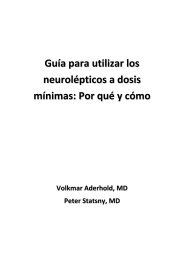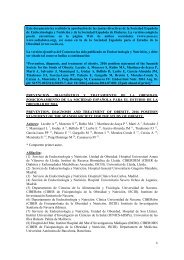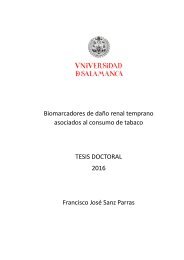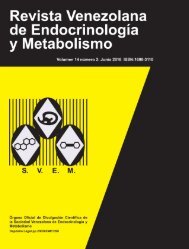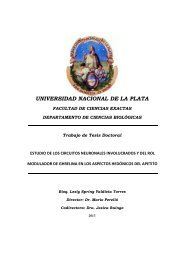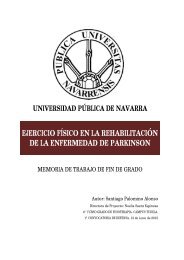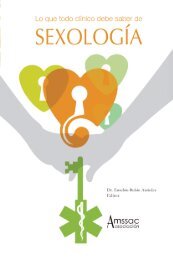Noviembre-Diciembre
156_v40n6(1)
156_v40n6(1)
Create successful ePaper yourself
Turn your PDF publications into a flip-book with our unique Google optimized e-Paper software.
Multidisciplinary teams involved: detection of drug-related problems… Farm Hosp. 2016;40(6):529-543 - 535<br />
System also features this role 21 . The so-called Integrated<br />
Healthcare Organizations have been created in Catalonia<br />
22 and in the Basque Country 23 . Our project is based<br />
on the role of the Pharmacist as the integrator of Continuity<br />
of Care in a multidisciplinary setting, who will communicate<br />
any DRP detected.<br />
In a DRP study conducted by German Pharmacists,<br />
271 DRPs were detected in 105 patients within a period<br />
of 6 months 24 . Our study includes more patients and a<br />
lower number of interventions, but data are similar.<br />
The drugs upon which more frequent interventions<br />
have been conducted are those included in Groups B, N,<br />
A and C. These data coincide with the medications upon<br />
which more interventions have been conducted in other<br />
studies described in bibliography 25,26 . This result can be<br />
due to the fact that Group N medications are some of<br />
the most widely used 27; regarding Group B, this can be<br />
caused by the incorporation of new oral anticoagulants<br />
to the market. These medications are prescribed by specialists<br />
and are subject to standardization (in Galicia, this<br />
standardization is conducted by PC and SC Pharmacists).<br />
The most frequent DRPs are similar to those described<br />
in bibliography. Thus, in the reconciliation study<br />
by Ucha-Samartin 28 , the most common DRP was dosing/<br />
inadequate interval.<br />
The actions in this project were to detect and solve<br />
DRPs, and any DRP prevented translates into adverse reaction<br />
prevention, reduction of visits to Emergency, and even<br />
prevention of re-hospitalizations 29 . Our project intends to<br />
add, improve, and provide new ideas to the concept of<br />
Continuity of Care, by involving the Pharmacist in patient<br />
care, and making them participate in the responsibility required<br />
by a safe and efficient drug therapy. The inclusion<br />
of the Pharmacist has a very important value in Continuity<br />
of Care, because this study was focused on healthcare<br />
education and identification of warming signs. A Pharmacist<br />
integrated in a multidisciplinary team will also be able<br />
to participate in the preparation of protocols for medication<br />
follow-up and reports, as well as acting upon adherence<br />
and other areas. The connection between the Primary<br />
Care Physician and the Primary Care Pharmacist and/<br />
or the SC Physician and the SC Pharmacist already existed<br />
within the same level of care. The additional value of this<br />
project was to join SC and PC through Pharmacist groups,<br />
as they are the professionals who will detect the DRP and<br />
communicate it to the rest of the multidisciplinary team.<br />
One of the limitations of this study is that an integrated<br />
clinical record is required for its extrapolation, and<br />
not all autonomous communities have access to this system.<br />
However, any country or autonomous community<br />
with Pharmacists in both levels (even from the Community<br />
Pharmacy setting), will be able to set up similar multidisciplinary<br />
models of action. On the other hand, our<br />
outcomes don’t allow us to obtain data about the reduction<br />
in number of re-hospitalizations or preventable deaths,<br />
as these are not the object of our practice of care. In<br />
the future, it will be necessary to validate this program,<br />
to quantify the severity of the DRPs detected, and to<br />
measure the economic impact of their prevention. It will<br />
also be necessary to measure the benefit achieved by<br />
optimization the drug therapy of patients, increasing the<br />
safety of the Continuity of Care process.<br />
Despite these limitations, we consider that the number<br />
of interventions is adequate in order to create awareness<br />
in professionals regarding the fact that Transition of Care<br />
is a real problem in our health system, regardless of the<br />
existence of integrated clinical records. The strengths of<br />
an on-going, safe and integrated Program for Transition<br />
of Care are: to ensure the best outcome in drug therapy<br />
for patients, and to guarantee access to the medication<br />
with an efficient and effective use. An adequate Transition<br />
of Care represents a challenge for the health system. If<br />
there is no adequate continuity, and the impenetrability of<br />
levels of care is not eliminated, DRPs will appear that can<br />
generate additional costs for the patient and the system;<br />
therefore, projects like this represent an improvement in<br />
patient care, as has been demonstrated by other studies 30 .<br />
Summing up, discrepancies / DRPs in patient records<br />
regarding drug therapy were detected and solved through<br />
the implementation of the e-CC Program among<br />
Pharmacists in both levels of care, with a high acceptance<br />
of interventions (84%).<br />
Conflict of Interests<br />
The authors hereby declare that there is no conflict<br />
of interests.<br />
Bibliography<br />
1. EuropeanPatients Smart Open Service (epSOSproject) [página<br />
web]. [Consultando el 07/05/2015]. Disponible en: http://www.<br />
epsos.eu/home/epsos-results-outlook.html<br />
2. InnovaSaude y Hospital2050 [página web]. [Consultando el<br />
08/05/2015]. Disponible en: http://www.sergas.es/MostrarContidos_N2_T01.aspx?IdPaxina=60433<br />
3. Gálvez Ibáñez. Continuidad asistencial. Análisis conceptual, de los<br />
actores y amenazas. Propuestas y alternativas. Medicina de Familia<br />
(And) [revista en Internet]. 2003 [citado 30/04/2014]; 4(1):58-66.<br />
Disponible en: http://www.samfyc.es/Revista/PDF/v 4 n1/09.pdf<br />
4. Reid R, Haggerty J, McKendry R. Defusing the confusion: Concepts<br />
and measures of continuity of healthcare [Canada]. Ottawa;<br />
2002. [consultando 30/01/2015]. Disponible en: http://www.cfhifcass.ca/Migrated/PDF/ResearchReports/CommissionedResearch/<br />
cr_contcare_e.pdf<br />
5. Estrategia SERGAS 2014. La Sanidad Pública al servicio del Paciente<br />
[Monografía en Internet]. Galicia: Servicio Gallego de Salud y<br />
Xunta de Galicia; 2014 [citado 8/11/2015]. Disponible en: http://<br />
www.sergas.es/Docs/Conselleria/Estrategia_Sergas_2014.pdf<br />
6. Delgado-Silveira E, Fernández-Villalba EM, García-Mina Freire M,<br />
Albiñana Pérez MS, CasajúsLagranja MP, Peris Martí JF. [The impact<br />
of Pharmacy Intervention on the treatment of elderly multi-pathological<br />
patients].FarmHosp. 2015;39(4):192-202.<br />
7. Galván Banqueri M, Alfaro Lara ER, Rincón Gómez M, Rivas Covas<br />
PC, Vega Coca MD, Nieto Martín MD. Factors related with the<br />
appropriateness of pharmacological treatment in polypathological<br />
patients. FarmHosp. 2014;38(5):405-10.




